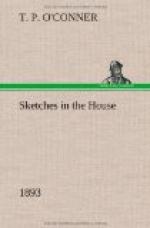There was the bathos of a poor speech from Colonel Nolan, and then the division. Everybody has the numbers now—34 majority—34 in spite of Saunders and Bolton, of absent Wallace, and unpaired Mr. Wilson. We cheer, counter cheer; we rise and wave our hats; and then quickly, quietly, even with a subdued air, we walk out and leave the halls of Parliament silent, dark, and echoless.
CHAPTER XIX.
HOME RULE IN THE LORDS.
[Sidenote: A brilliant scene.]
The brilliancy of the scene in the House of Lords on September 4th, when the fight over the Home Rule Bill began, was undeniable. Standing at the bar, in that small space which is reserved for members of the other Chamber, and looking out at the view, it was, I thought, one of the most picturesque and brilliant spectacles on which my eye had ever rested. The beauty of the House of Commons is great. But it is undoubtedly inferior in beauty to the House of Lords. In the House of Commons the roof is a false one, for the original loftiness of the ceiling was found too great to allow anyone to be properly heard. But in the House of Lords, where the acoustic properties are still extremely bad, the anxiety to hear its members has not yet proved great enough to induce them to make any change in the roof, with the result that the Chamber gives you an impression of loftiness, spaciousness, and sweep, such as you do not find in the other. And then the walls at the end obtain additional splendour from the fine pictures that there stand out and confront you—pictures full of crowded life, movement, and tragedy. The Throne, too, with all its gilded splendour, remains, even in its emptiness, a reminder of that stately and opulent lordship which our institutions give to a great personage above all parties and all classes.
[Sidenote: Lovely woman.]




